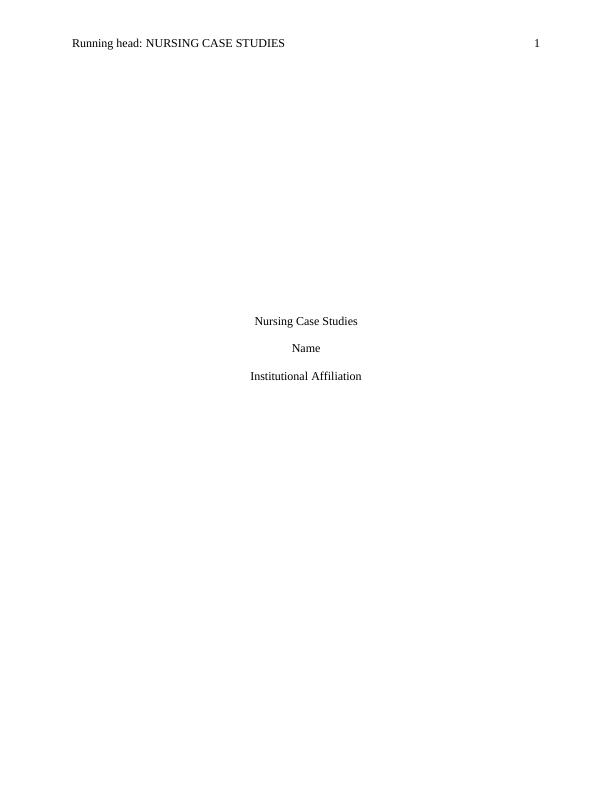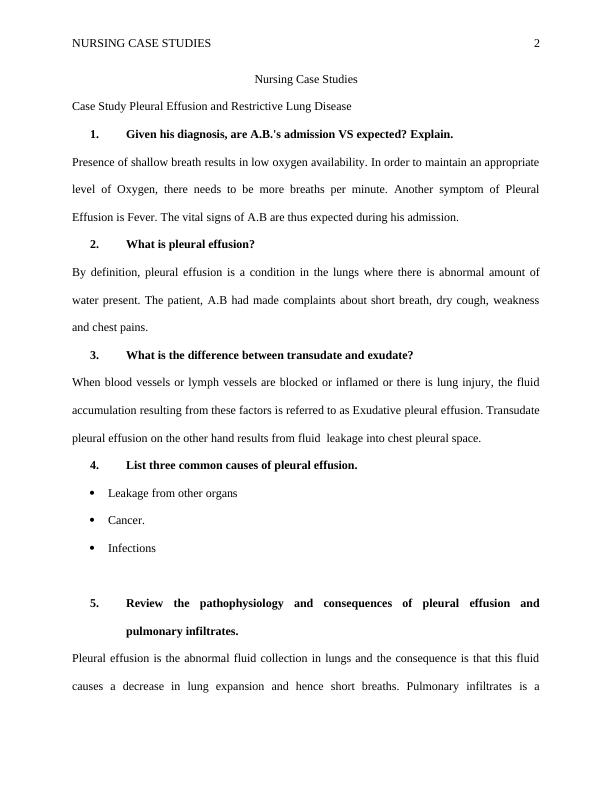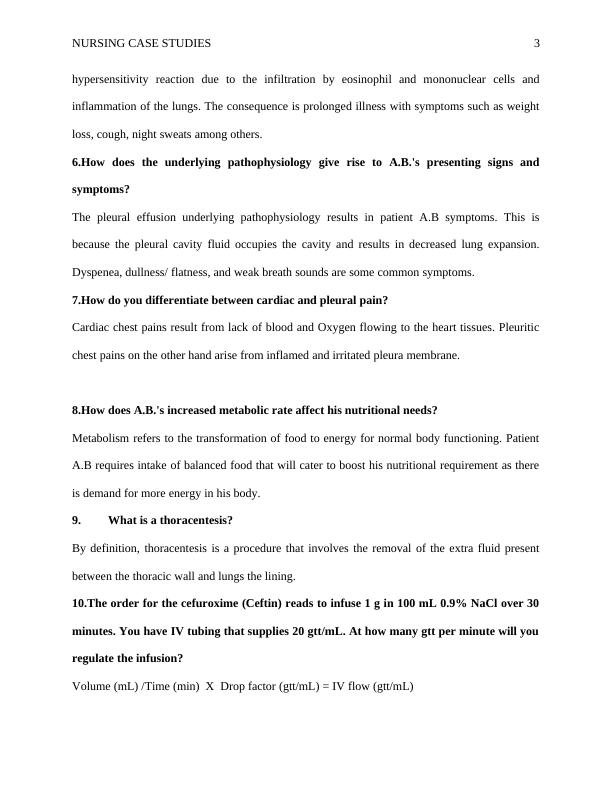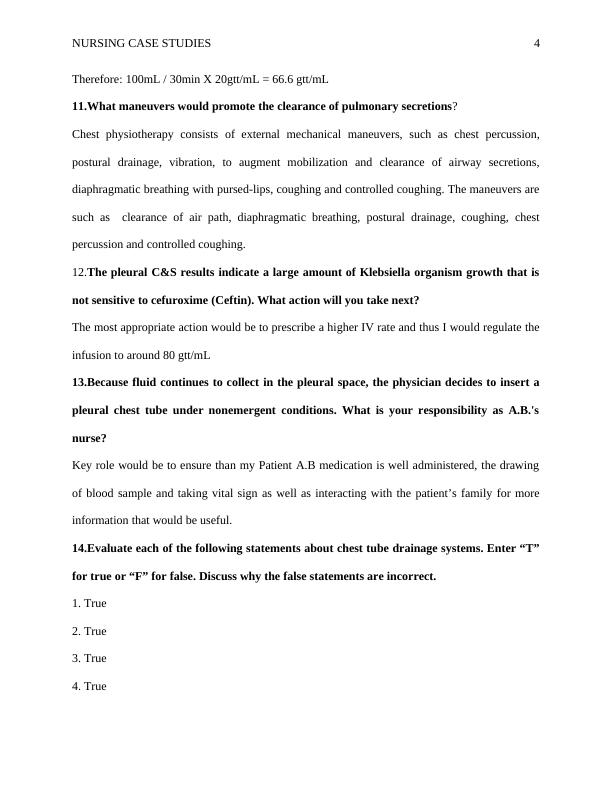Ask a question from expert
Nursing Case Studies
13 Pages2669 Words146 Views
Added on 2020-03-16
Nursing Case Studies
Added on 2020-03-16
BookmarkShareRelated Documents
Running head: NURSING CASE STUDIES 1
Nursing Case Studies
Name
Institutional Affiliation
Nursing Case Studies
Name
Institutional Affiliation

NURSING CASE STUDIES 2
Nursing Case Studies
Case Study Pleural Effusion and Restrictive Lung Disease
1. Given his diagnosis, are A.B.'s admission VS expected? Explain.
Presence of shallow breath results in low oxygen availability. In order to maintain an appropriate
level of Oxygen, there needs to be more breaths per minute. Another symptom of Pleural
Effusion is Fever. The vital signs of A.B are thus expected during his admission.
2. What is pleural effusion?
By definition, pleural effusion is a condition in the lungs where there is abnormal amount of
water present. The patient, A.B had made complaints about short breath, dry cough, weakness
and chest pains.
3. What is the difference between transudate and exudate?
When blood vessels or lymph vessels are blocked or inflamed or there is lung injury, the fluid
accumulation resulting from these factors is referred to as Exudative pleural effusion. Transudate
pleural effusion on the other hand results from fluid leakage into chest pleural space.
4. List three common causes of pleural effusion.
Leakage from other organs
Cancer.
Infections
5. Review the pathophysiology and consequences of pleural effusion and
pulmonary infiltrates.
Pleural effusion is the abnormal fluid collection in lungs and the consequence is that this fluid
causes a decrease in lung expansion and hence short breaths. Pulmonary infiltrates is a
Nursing Case Studies
Case Study Pleural Effusion and Restrictive Lung Disease
1. Given his diagnosis, are A.B.'s admission VS expected? Explain.
Presence of shallow breath results in low oxygen availability. In order to maintain an appropriate
level of Oxygen, there needs to be more breaths per minute. Another symptom of Pleural
Effusion is Fever. The vital signs of A.B are thus expected during his admission.
2. What is pleural effusion?
By definition, pleural effusion is a condition in the lungs where there is abnormal amount of
water present. The patient, A.B had made complaints about short breath, dry cough, weakness
and chest pains.
3. What is the difference between transudate and exudate?
When blood vessels or lymph vessels are blocked or inflamed or there is lung injury, the fluid
accumulation resulting from these factors is referred to as Exudative pleural effusion. Transudate
pleural effusion on the other hand results from fluid leakage into chest pleural space.
4. List three common causes of pleural effusion.
Leakage from other organs
Cancer.
Infections
5. Review the pathophysiology and consequences of pleural effusion and
pulmonary infiltrates.
Pleural effusion is the abnormal fluid collection in lungs and the consequence is that this fluid
causes a decrease in lung expansion and hence short breaths. Pulmonary infiltrates is a

NURSING CASE STUDIES 3
hypersensitivity reaction due to the infiltration by eosinophil and mononuclear cells and
inflammation of the lungs. The consequence is prolonged illness with symptoms such as weight
loss, cough, night sweats among others.
6.How does the underlying pathophysiology give rise to A.B.'s presenting signs and
symptoms?
The pleural effusion underlying pathophysiology results in patient A.B symptoms. This is
because the pleural cavity fluid occupies the cavity and results in decreased lung expansion.
Dyspenea, dullness/ flatness, and weak breath sounds are some common symptoms.
7.How do you differentiate between cardiac and pleural pain?
Cardiac chest pains result from lack of blood and Oxygen flowing to the heart tissues. Pleuritic
chest pains on the other hand arise from inflamed and irritated pleura membrane.
8.How does A.B.'s increased metabolic rate affect his nutritional needs?
Metabolism refers to the transformation of food to energy for normal body functioning. Patient
A.B requires intake of balanced food that will cater to boost his nutritional requirement as there
is demand for more energy in his body.
9. What is a thoracentesis?
By definition, thoracentesis is a procedure that involves the removal of the extra fluid present
between the thoracic wall and lungs the lining.
10.The order for the cefuroxime (Ceftin) reads to infuse 1 g in 100 mL 0.9% NaCl over 30
minutes. You have IV tubing that supplies 20 gtt/mL. At how many gtt per minute will you
regulate the infusion?
Volume (mL) /Time (min) X Drop factor (gtt/mL) = IV flow (gtt/mL)
hypersensitivity reaction due to the infiltration by eosinophil and mononuclear cells and
inflammation of the lungs. The consequence is prolonged illness with symptoms such as weight
loss, cough, night sweats among others.
6.How does the underlying pathophysiology give rise to A.B.'s presenting signs and
symptoms?
The pleural effusion underlying pathophysiology results in patient A.B symptoms. This is
because the pleural cavity fluid occupies the cavity and results in decreased lung expansion.
Dyspenea, dullness/ flatness, and weak breath sounds are some common symptoms.
7.How do you differentiate between cardiac and pleural pain?
Cardiac chest pains result from lack of blood and Oxygen flowing to the heart tissues. Pleuritic
chest pains on the other hand arise from inflamed and irritated pleura membrane.
8.How does A.B.'s increased metabolic rate affect his nutritional needs?
Metabolism refers to the transformation of food to energy for normal body functioning. Patient
A.B requires intake of balanced food that will cater to boost his nutritional requirement as there
is demand for more energy in his body.
9. What is a thoracentesis?
By definition, thoracentesis is a procedure that involves the removal of the extra fluid present
between the thoracic wall and lungs the lining.
10.The order for the cefuroxime (Ceftin) reads to infuse 1 g in 100 mL 0.9% NaCl over 30
minutes. You have IV tubing that supplies 20 gtt/mL. At how many gtt per minute will you
regulate the infusion?
Volume (mL) /Time (min) X Drop factor (gtt/mL) = IV flow (gtt/mL)

NURSING CASE STUDIES 4
Therefore: 100mL / 30min X 20gtt/mL = 66.6 gtt/mL
11.What maneuvers would promote the clearance of pulmonary secretions?
Chest physiotherapy consists of external mechanical maneuvers, such as chest percussion,
postural drainage, vibration, to augment mobilization and clearance of airway secretions,
diaphragmatic breathing with pursed-lips, coughing and controlled coughing. The maneuvers are
such as clearance of air path, diaphragmatic breathing, postural drainage, coughing, chest
percussion and controlled coughing.
12.The pleural C&S results indicate a large amount of Klebsiella organism growth that is
not sensitive to cefuroxime (Ceftin). What action will you take next?
The most appropriate action would be to prescribe a higher IV rate and thus I would regulate the
infusion to around 80 gtt/mL
13.Because fluid continues to collect in the pleural space, the physician decides to insert a
pleural chest tube under nonemergent conditions. What is your responsibility as A.B.'s
nurse?
Key role would be to ensure than my Patient A.B medication is well administered, the drawing
of blood sample and taking vital sign as well as interacting with the patient’s family for more
information that would be useful.
14.Evaluate each of the following statements about chest tube drainage systems. Enter “T”
for true or “F” for false. Discuss why the false statements are incorrect.
1. True
2. True
3. True
4. True
Therefore: 100mL / 30min X 20gtt/mL = 66.6 gtt/mL
11.What maneuvers would promote the clearance of pulmonary secretions?
Chest physiotherapy consists of external mechanical maneuvers, such as chest percussion,
postural drainage, vibration, to augment mobilization and clearance of airway secretions,
diaphragmatic breathing with pursed-lips, coughing and controlled coughing. The maneuvers are
such as clearance of air path, diaphragmatic breathing, postural drainage, coughing, chest
percussion and controlled coughing.
12.The pleural C&S results indicate a large amount of Klebsiella organism growth that is
not sensitive to cefuroxime (Ceftin). What action will you take next?
The most appropriate action would be to prescribe a higher IV rate and thus I would regulate the
infusion to around 80 gtt/mL
13.Because fluid continues to collect in the pleural space, the physician decides to insert a
pleural chest tube under nonemergent conditions. What is your responsibility as A.B.'s
nurse?
Key role would be to ensure than my Patient A.B medication is well administered, the drawing
of blood sample and taking vital sign as well as interacting with the patient’s family for more
information that would be useful.
14.Evaluate each of the following statements about chest tube drainage systems. Enter “T”
for true or “F” for false. Discuss why the false statements are incorrect.
1. True
2. True
3. True
4. True

End of preview
Want to access all the pages? Upload your documents or become a member.
Related Documents
Pleural Effusion Diagnosislg...
|8
|1655
|19
Acute Respiratory Distress Syndrome (ARDS) - Pathophysiology, Management, and pH Changeslg...
|4
|788
|89
Pathophysiology of COPD and its Relationship with Clinical Condition: A Case Studylg...
|10
|3002
|63
Shortness of Breath | Case Studylg...
|2
|659
|15
Life Threatening Condition - Case Study Analysis and Nursing Care Planlg...
|4
|918
|314